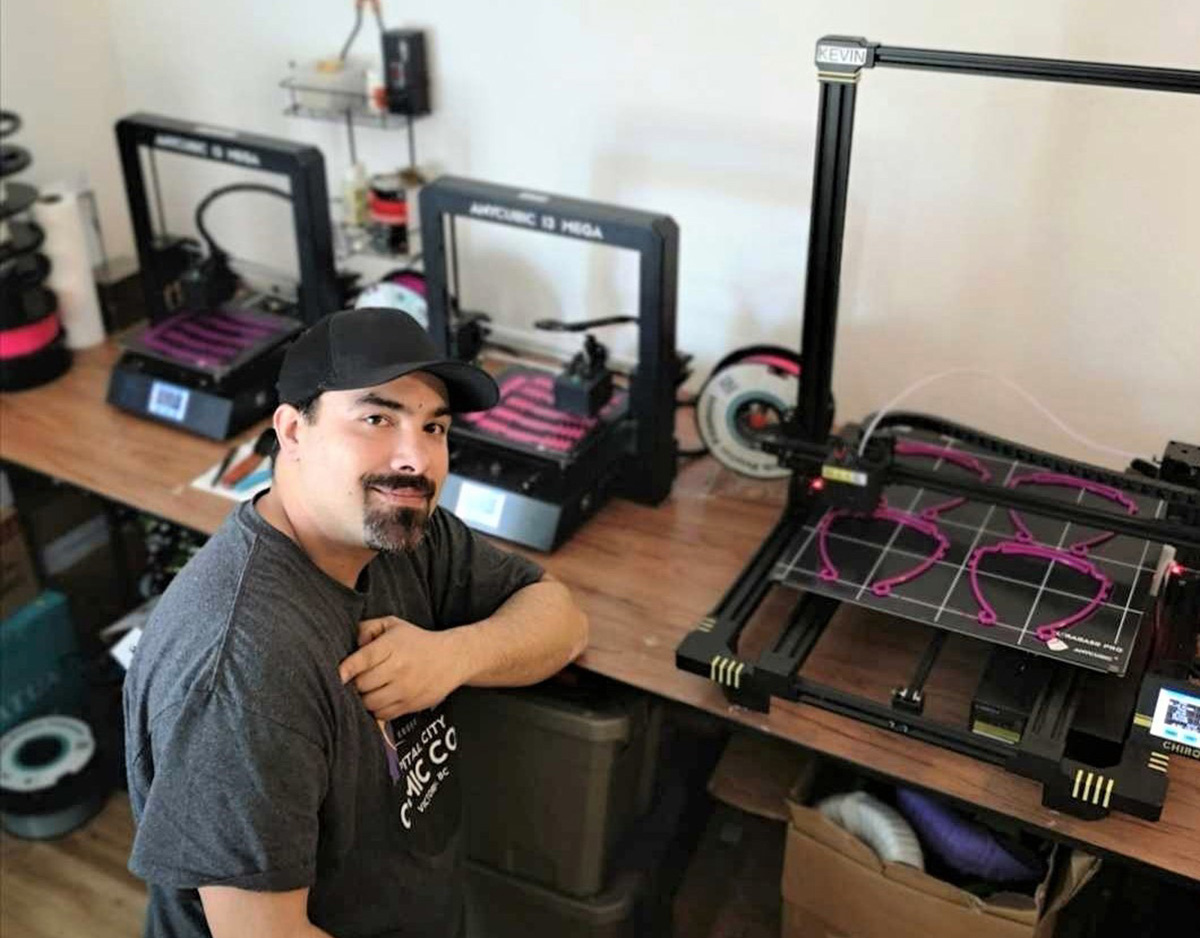Kelly Burns was using his 3D printers to make costumes for cosplayers — people who dress up as characters from video games or movies — when the coronavirus pandemic killed his business.
Now he’s making safety gear for health-care workers.
“I’m not really doing anything right now, so why not put all my effort into helping out the community?” Burns said. “We’re just here to help. Care workers are helping us and we’re trying to help them back.”
Burns has joined an ad hoc online group of some 500 people who are part of a wider effort to help address shortages of personal protective equipment that have seen manufacturers re-tool to make face masks and items needed by health-care workers.
Burns got into 3D printing a little more than a year ago. A parent of two, he’d been a cook at the University of Victoria but left that job to create a home-based business that lets him be closer to his family and do something he’s passionate about.
“I get paid to play dress up with my kids,” he said, offering Legion of Doom characters as an example of the costumes he creates. “I make everything, from the feet to the hats.” He uses foam for things like armour, and the 3D printers to make the plastic parts or props needed to complete a costume.
Before the pandemic Burns was selling his products around the world. But now comic cons and other events popular with the cosplay community have been cancelled, people are losing their jobs and cutting spending, and shipping delays are killing demand.
So Burns changed course. On YouTube he found instructions on how to make headbands to hold plastic face shields used by health-care workers, as well as “ear saver” straps worn on the back of the head and used to attach the elastics for a face mask.
“I figured why not. I have all this spare time. I have three 3D printers not working.”
Within a couple days he had produced more than 100 units, but had no idea how to get them to people who need them. Turning to Reddit, he found the B.C. COVID-19 3D Printing Group that had sprung up to co-ordinate the efforts of people like him.
One of the BCC3D group’s two co-ordinators on Vancouver Island is Jason Murray. He came home in March from his job as a software engineer in Germany to be near family during the pandemic. While fighting the boredom of two weeks in self-isolation, he connected through Reddit with others working on the effort.
“This is a group of over 500 volunteers who are working to supply this demand,” Murray said. “This is not just some guy in the garage. Well it ends up being a whole bunch of guys in the garage, but that’s a whole different story.”
Between them the volunteers have access to some 1,200 3D printers and can produce hundreds of face shields and ear savers a day, he said.
The group’s website stresses that the shields are not approved by Health Canada and should not be considered medical devices. “They are produced in the community and intended to meet an urgent need. Use them at your own risk.”
The Capital, a website based in Victoria, quoted Island Health protection services officer Tyson Walters saying he’d asked the group for 250 ear savers, 50 headbands and 70 face shields and distributed them in Duncan. The quality was good, he said. “The staff that I've interacted with that have used them are pretty happy.”
Murray said the focus has been on providing equipment to health-care providers outside the Island Health Authority who might not otherwise have access during a supply shortage, such as individual doctors’ offices or midwives.
The demand for the shields has been strong and the people receiving them can be confident they aren’t taking them away from others on the frontlines who might need them more, he said. “We are focused on B.C., but we are also co-ordinating some teams in Alberta and Ontario, and have received requests from as far away as South Carolina.”
At this point the limiting factor is access to clear plastic sheeting to make the part of the shield that covers the face. Some kinds of plastic are better than others, but the group will take whatever kind of transparent plastic it can get, Murray said, adding that the kind of plastic businesses might have on hand to make packaging works well.
“We are certain there are pallets of it sitting in somebody’s warehouse right now that are... just waiting.”
It feels good to be doing something to help, Murray said.
“Our health-care providers are likely going out there without the supplies that they need,” he said. “These people are literally dying for us and the least we can do is give them the equipment to last as long as they can.”
Burns too said it’s rewarding to be producing something that’s needed. “It’s a good feeling.”
Having now added a couple more printers, he can make about 200 ear savers and up to 50 headbands a day at a cost of less than 50 cents each and wants to let people know they are available. “The hardest part right now is getting the word out.” ![]()
Read more: Health, Coronavirus, Labour + Industry
















Tyee Commenting Guidelines
Comments that violate guidelines risk being deleted, and violations may result in a temporary or permanent user ban. Maintain the spirit of good conversation to stay in the discussion.
*Please note The Tyee is not a forum for spreading misinformation about COVID-19, denying its existence or minimizing its risk to public health.
Do:
Do not: